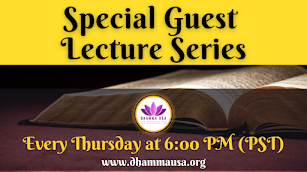Buddhism, with its profound philosophical underpinnings and practical ethical guidance, is rooted in the teachings of the Buddha. Central to these teachings are the Four Noble Truths and the Noble Eightfold Path, which provide a comprehensive framework for understanding and overcoming suffering. This essay will explore these foundational doctrines from the Theravāda perspective, emphasizing their significance and application in the Theravada tradition. References will be drawn from the Pali Tipitaka, the canonical scriptures of Theravāda Buddhism.
The Four Noble Truths
The Four Noble Truths form the core of the Buddha’s teaching, encapsulating the essence of his enlightenment experience. These truths are:
- The Truth of Suffering (Dukkha)
- The Truth of the Origin of Suffering (Samudaya)
- The Truth of the Cessation of Suffering (Nirodha)
- The Truth of the Path to the Cessation of Suffering (Magga)
The Truth of Suffering (Dukkha)
The first noble truth acknowledges the pervasive nature of suffering in human existence. It recognizes that life, in its various forms, is marked by dissatisfaction, impermanence, and pain. The Buddha described this truth in the Dhammacakkappavattana Sutta (SN 56.11), stating, "Birth is suffering, aging is suffering, sickness is suffering, death is suffering; sorrow, lamentation, pain, grief, and despair are suffering; association with the unloved is suffering; separation from the loved is suffering; not to get what one wants is suffering; in brief, the five aggregates subject to clinging are suffering."
The Truth of the Origin of Suffering (Samudaya)
The second noble truth identifies the origin of suffering as craving (taṇhā), which arises from ignorance (avijjā). This craving manifests in three forms: craving for sensual pleasures (kāma-taṇhā), craving for existence (bhava-taṇhā), and craving for non-existence (vibhava-taṇhā). The Buddha elaborates on this in the Vibhaṅga Sutta (SN 12.2), where he explains that craving leads to clinging, which in turn perpetuates the cycle of birth and death (saṃsāra).
The Truth of the Cessation of Suffering (Nirodha)
The third noble truth asserts that the cessation of suffering is attainable through the abandonment of craving. This state of liberation is known as Nibbāṇa (Nirvāna), described as the ultimate peace and freedom from the cycles of birth and death. The Buddha elucidates this in the Nibbāṇa Sutta (Itivuttaka 44), stating, "This, bhikkhus, is the cessation of suffering: the remainderless fading away and cessation of that same craving, the giving up and relinquishing of it, freedom from it, nonreliance on it."
The Truth of the Path to the Cessation of Suffering (Magga)
The fourth noble truth prescribes the Noble Eightfold Path as the practical means to achieve the cessation of suffering. This path encompasses ethical conduct, mental discipline, and wisdom, providing a holistic approach to spiritual development.
The Noble Eightfold Path
The Noble Eightfold Path is divided into three main categories: wisdom (paññā), ethical conduct (sīla), and mental discipline (samādhi). The path comprises the following eight elements:
- Right Understanding (Sammā Diṭṭhi)
- Right Thought (Sammā Saṅkappa)
- Right Speech (Sammā Vācā)
- Right Action (Sammā Kammanta)
- Right Livelihood (Sammā Ājīva)
- Right Effort (Sammā Vāyāma)
- Right Mindfulness (Sammā Sati)
- Right Concentration (Sammā Samādhi)
Wisdom (Paññā)
Right Understanding (Sammā Diṭṭhi)
Right understanding is the correct comprehension of the Four Noble Truths and the nature of reality. It involves seeing things as they truly are, free from delusion and ignorance. This foundational element is crucial for guiding one’s thoughts and actions towards liberation. The Buddha explains this in the Mahāsatipaṭṭhāna Sutta (DN 22), emphasizing the importance of understanding the impermanence (anicca), suffering (dukkha), and non-self (anatta) nature of all phenomena.
Right Thought (Sammā Saṅkappa)
Right thought refers to the cultivation of thoughts that are free from sensual desire, ill-will, and harmful intent. It involves developing thoughts of renunciation, goodwill, and harmlessness. This aspect of the path aligns with the Buddha’s teaching in the Dvedhāvitakka Sutta (MN 19), where he discusses the importance of directing one’s mind towards thoughts that are conducive to spiritual growth.
Ethical Conduct (Sīla)
Right Speech (Sammā Vācā))
Right speech entails abstaining from falsehood, slander, harsh words, and idle chatter. It encourages speaking truthfully, harmoniously, kindly, and meaningfully. The Buddha highlights the significance of right speech in the Saccavibhaṅga Sutta (MN 141), outlining the four types of virtuous speech.
Right Action (Sammā Kammanta)
Right action involves adhering to ethical behavior by abstaining from killing, stealing, and sexual misconduct. It promotes actions that are peaceful, honest, and respectful of others’ rights and well-being. The Buddha’s instructions in the Dhammika Sutta (Snp 2.14) provide guidance on maintaining ethical conduct in daily life.
Right Livelihood (Sammā Ājīva)
Right livelihood means earning a living in a way that does not cause harm to others. It encourages choosing professions that are ethical and contribute positively to society. The Buddha advises against trades that involve harm in the Vanijja Sutta (AN 5.177), such as dealing in weapons, intoxicants, or slavery.
Mental Discipline (Samādhi)
Right Effort (Sammā Vāyāma)
Right effort involves the diligent cultivation of wholesome states of mind and the abandonment of unwholesome ones. It includes the effort to prevent and overcome unwholesome thoughts while developing and maintaining wholesome thoughts. This practice is emphasized in the Padhāna Sutta (SN 45.8), where the Buddha describes the four right efforts.
Right Mindfulness (Sammā Sati)
Right mindfulness is the practice of maintaining awareness of the body, feelings, mind, and mental phenomena. It involves continuous attention to one’s experiences and mental states, fostering clarity and insight. The Buddha’s detailed instructions on mindfulness are found in the Satipaṭṭhāna Sutta (MN 10), highlighting the four foundations of mindfulness.
Right Concentration (Sammā Samādhi)
Right concentration refers to the development of deep meditative states, or jhānas, which focus the mind and lead to heightened states of awareness and tranquility. This concentration supports the cultivation of wisdom and the attainment of Nibbana. The Buddha discusses the practice of jhāna in the Samādhaṅga Sutta (AN 5.28), describing the factors and benefits of right concentration.
Conclusion
The Four Noble Truths and the Noble Eightfold Path are central to the Theravāda Buddhist tradition, providing a comprehensive framework for understanding and overcoming suffering. These teachings emphasize ethical conduct, mental discipline, and wisdom, guiding practitioners towards liberation and enlightenment. By following this path, individuals can cultivate a life of compassion, mindfulness, and profound insight into the nature of reality.
References
- Bodhi, Bhikkhu, ed. In the Buddha's Words: An Anthology of Discourses from the Pali Canon. Wisdom Publications, 2005.
- "Dhammacakkappavattana Sutta: Setting the Wheel of Dhamma in Motion (SN 56.11)." Translated by Bhikkhu Bodhi. Access to Insight (Legacy Edition), https://www.accesstoinsight.org/tipitaka/sn/sn56/sn56.011.bodh.html.
- "Samyutta Nikaya (SN 12.2)." Translated by Bhikkhu Bodhi. Wisdom Publications, 2000.
- "Itivuttaka 44." Translated by John D. Ireland. Access to Insight (Legacy Edition), https://www.accesstoinsight.org/tipitaka/kn/iti/iti.1.044.irel.html.
- "Mahasatipatthana Sutta: The Great Discourse on Establishing Mindfulness (DN 22)." Translated by Bhikkhu Bodhi. Access to Insight (Legacy Edition), https://www.accesstoinsight.org/tipitaka/dn/dn.22.0.than.html.
- "Dvedhavitakka Sutta: Two Kinds of Thought (MN 19)." Translated by Bhikkhu Nanamoli and Bhikkhu Bodhi. Access to Insight (Legacy Edition), https://www.accesstoinsight.org/tipitaka/mn/mn.019.than.html.
- "Saccavibhanga Sutta: An Analysis of the Truths (MN 141)." Translated by Bhikkhu Nanamoli and Bhikkhu Bodhi. Access to Insight (Legacy Edition), https://www.accesstoinsight.org/tipitaka/mn/mn.141.bpit.html.
- "Dhammika Sutta (Snp 2.14)." Translated by Bhikkhu Bodhi. Access to Insight (Legacy Edition), https://www.accesstoinsight.org/tipitaka/kn/snp/snp.2.14.bodh.html.
- "Vanijja Sutta: Right Livelihood (AN 5.177)." Translated by Bhikkhu Bodhi. Access to Insight (Legacy Edition), https://www.accesstoinsight.org/tipitaka/an/an05/an05.177.than.html.
- "Padhana Sutta: The Great Struggle (SN 45.8)." Translated by Bhikkhu Bodhi. Access to Insight (Legacy Edition), https://www.accesstoinsight.org/tipitaka/sn/sn45/sn45.008.than.html.
- "Satipatthana Sutta: The Foundations of Mindfulness (MN 10)." Translated by Bhikkhu Nanamoli and Bhikkhu Bodhi. Access to Insight (Legacy Edition), https://www.accesstoinsight.org/tipitaka/mn/mn.010.than.html.
- "Samadhanga Sutta: The Factors of Concentration (AN 5.28)." Translated by Bhikkhu Bodhi. Access to Insight (Legacy Edition), https://www.accesstoinsight.org/tipitaka/an/an05/an05.028.than.html.
- Gethin, Rupert. The Foundations of Buddhism. Oxford University Press, 1998.
- Harvey, Peter. An Introduction to Buddhist Ethics: Foundations, Values, and Issues. Cambridge University Press, 2000.































I wish many Buddhists are able to read & understand. It’s so clear &simply worded.Saadu Saadu Sumitta Bhante
ReplyDelete